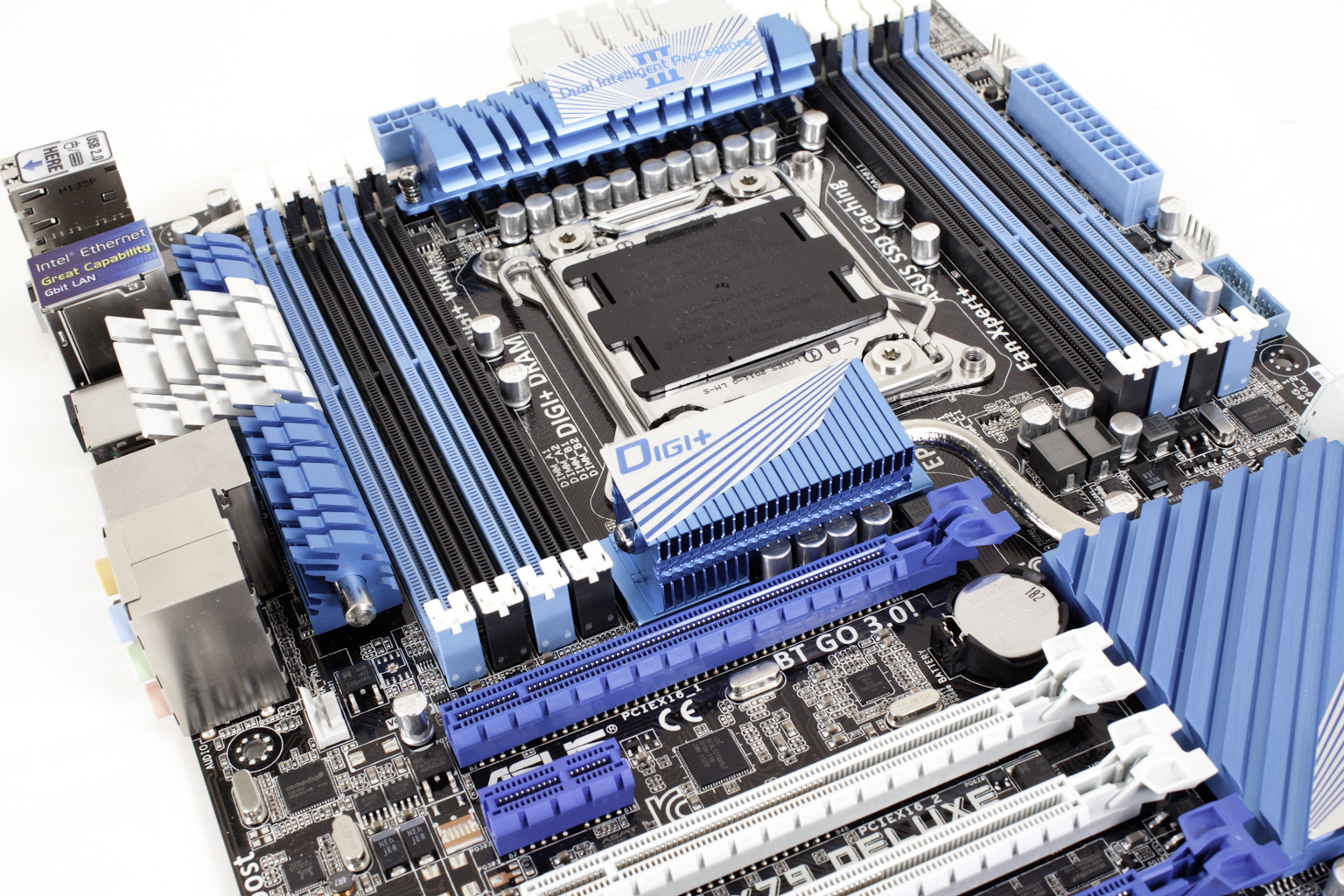Section 1 Subsystems
Memory -
Memory performance is very important on a motherboard, especially when you have a CPU with multiple cores and threads. If you have slow memory your cores and threads can become starved for data to execute. To test memory performance we run both Sisoft’s SANDRA and AIDA64. These two combine to not only give us accurate numbers but to validate each other. For testing at stock speeds the memory is hard set to 1333MHz while overclocking testing is done at the highest stable speed for the voltage of 1.65v this is due to the different memory dividers for each CPU. As such, the memory speeds will vary greatly. This means that the overclocked numbers are a little misleading and while they can show a trend are really only included to show if a board has a problem with memory performance at high clockspeeds.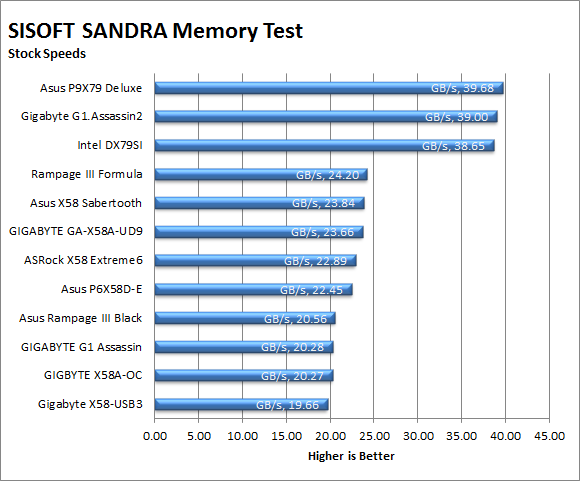
The Asus P9X79 Deluxe has some excellent memory performance at both stock and overclocked speeds. In our stock testing it manages to outperform all of the other boards we have in the lab by around 600MB/s.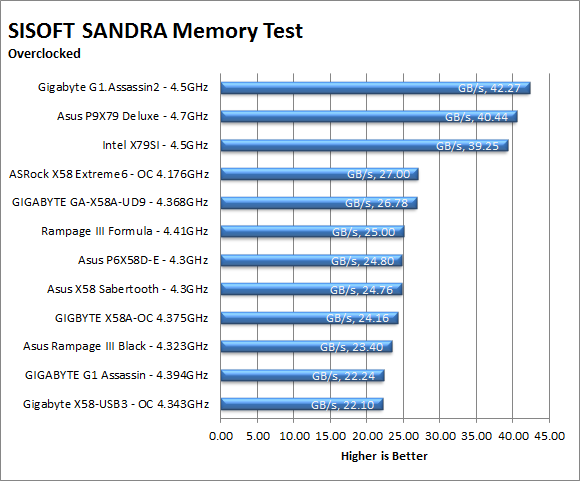
With our max stable OC we were not able to push the memory too far this resulted in a minor boost to memory bandwidth, but not enough to make it to first place. Still we can see the raw memory performance on the Asus board. This will come in handy later during our rendering and even general usage tests.
| AIDA64 Stock Memory Performance | AIDA64 Overclocked Memory Performance |
 |
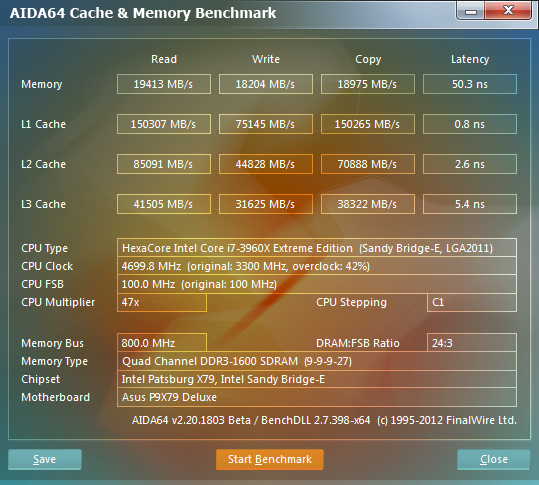 |
The AIDA64 results round out the aggregate memory performance number that SANDRA gives us. Here we see a little more detail on why the Asus P9X79 Deluxe has good memory performance and should do well in other memory intensive tests.
Drive performance -
Drive performance is also one of the major subsystems that goes to make up the performance of a motherboard. For our testing we use Sandra and AIDA64 again. We only test with single drives for each type of controller present on the motherboard (unless it is a professional product where we will use RIAD 5 and/or 10). We have also begun using a Seagate PS-110 USB 3 external HDD for our USB 3.0 performance. As a side note, we include the overclocked numbers here to make sure (again) that you are not going to see a major drop in performance due to minor instabilities at high clock speeds.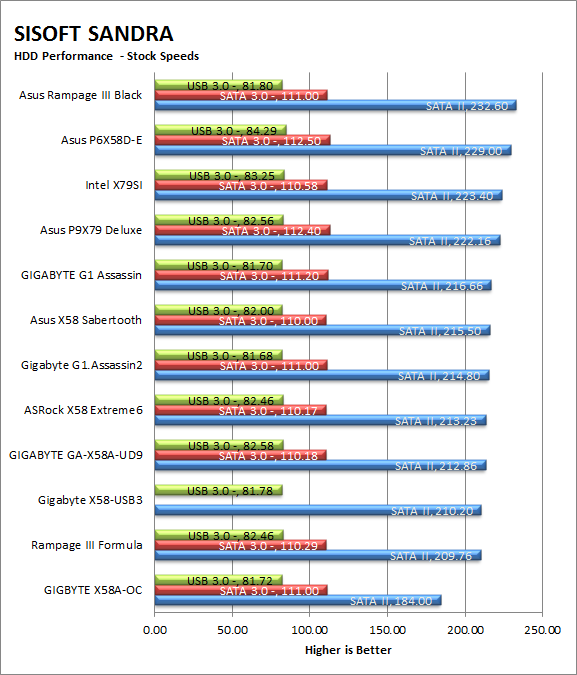
The drive performance fell pretty much where we expected it to. The P9X79 Deluxe did well in terms of drive performance but it did not stand out from the crowd. Fortunately the drive performance was good enough that we do not feel it will impact any of our other performance tests.
Once again AIDA64 shows us our performance with more detail than the aggregate numbers from SANDRA.
| AIDA64 Stock HDD Performance | AIDA64 Overclocked HDD Performance |
 |
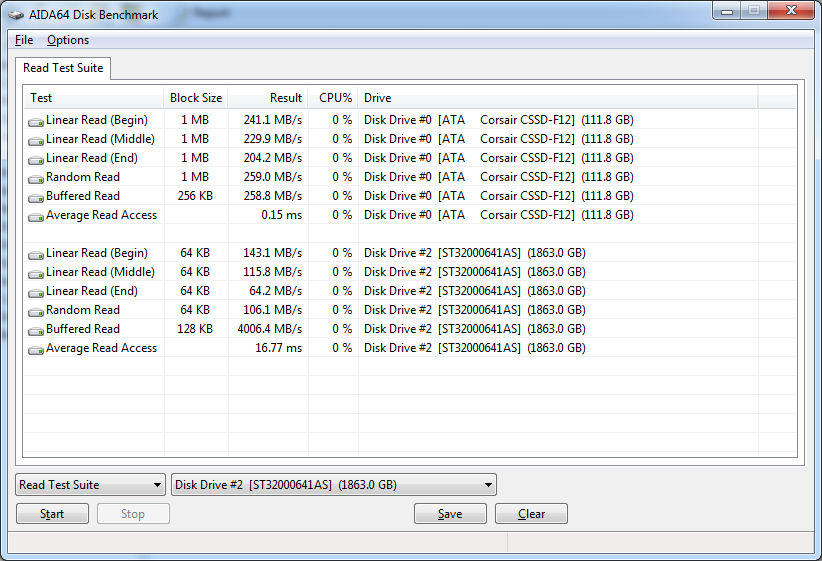 |
| AIDA64 Stock USB 3.0 Performance | AIDA64 Overlcocked USB 3.0 Performance |
 |
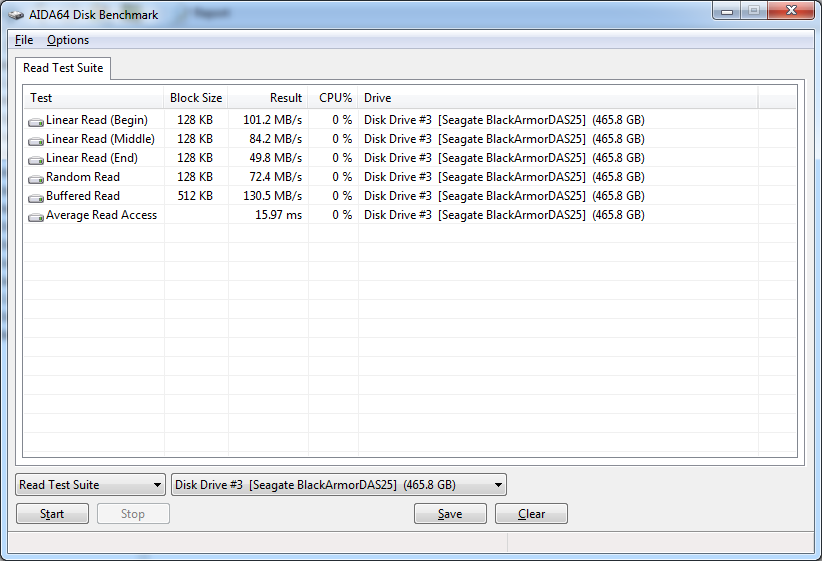 |
Power -
Power efficiency is another of those misnomers that we get caught up in. We hear about idle states and power gates. But what does that mean to you and I? On the surface having power management that reduces idle power sounds great and can be a benefit to someone that leaves their system on for long periods of time (and inactive) but how a system handles power under load and the delta between the two states is often more important than the idle power usage numbers. We use only P3 Kill A Watt instruments for measuring power. 
Normally Asus motherboards are very power efficient when you leave them at auto settings. As Asus has explained their EPU hardware is able to apply an undervolt to the CPU and hardware to help reduce both idle and load temperatures and power draw. On the P9X79 Deluxe with everything attached and running this pulled about 153 Watts from the wall on average, under load we saw this jump up to 279 Watts. This puts it in the middle of the pack and is not what we would normally expect from Asus. 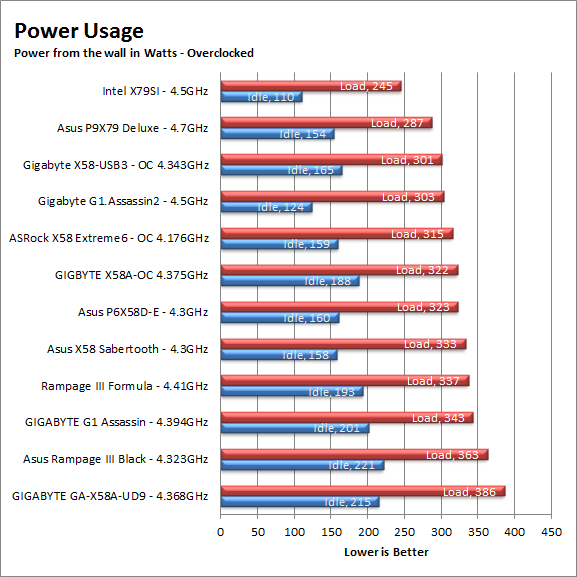
During our overclocking run we found that the power draw at idle was not that much more over the stock speeds, under load this increased (of course) but was still low enough to put this in second place for power efficiency. We suspect that the WiFi and BT Module are affecting this result as is the native PCIe 3.0 mode, if you are not using a PCIe Gen 3 GPU I would hard set your slots to Gen 2.0 and save some power.
Cooling (Board Level) -
Board level cooling is an important factor in product performance and longevity. Components like the chipset, VRM modules and even capacitors need to be kept relatively cool to prevent failure. As these parts are made of silicon, they have a thermal breakdown threshold; or melting point. At that temperature the actual transistors built into chip will begin to deform and break down. Granted, the threshold is often very high, but you still need to make sure that components stay away from this level of heat for longer product life. 
The board level cooling on the P9X79 Deluxe is good. Unfortunately it is designed with air flow in mind. When we ran this in our open test bench with no forced air flow the heatsinks over the VRMs became warm pretty fast. This put them at right around last place for cooling. The delta between the coolest running board and the P9X79 was 6.3c which is quite a bit to be honest. We would recommend making sure you have good air flow in your case when using this motherboard. 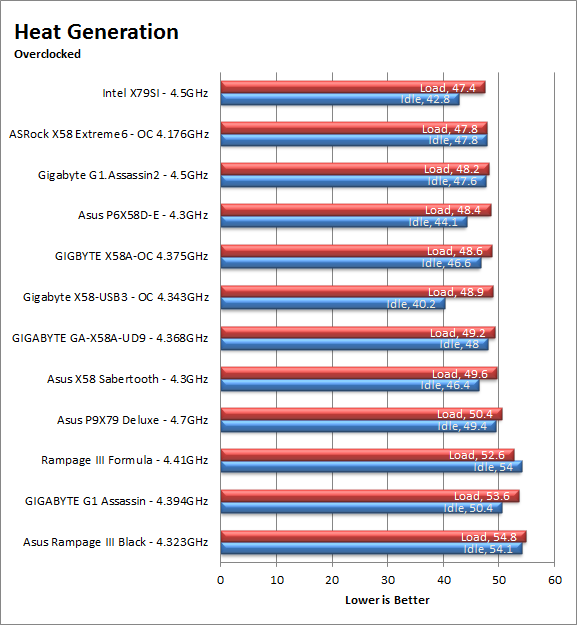
Audio -
Audio is highly subjective. What we find pleasing may sound “off” to you. That is always going to the problem with testing audio; results will vary too widely depending on the tastes of the listener. However, there are ways of measuring the audio output with an objective ear. There is also the issue of audio causing performance issues in gaming and video playback. The reason this is a potential source of concern is that all onboard audio CODECs (Compression/Decompression) are CPU controlled. This means that while the audio chip controls the audio levels and effects of the audio the actual work is done on the CPU. Usually this will not be a problem with today’s powerful CPUs. Even the lower and consumer level products can handle high-end audio these days. But again there is the chance that a bad design or software will hinder your system and performance. On the other side the limits of board space, cost, etc will also prevent the level of audio quality you can get from an add-in board. We test all audio parts with three media types, Movie (DVD), MP3 Music, and Gaming. These are pushed to our Tec On model 55 Tube Amp to see if we can detect any signal issues in the reproduction.
The Audio on the P9X79 Deluxe was average for a motherboard in its class. It is using a slightly newer Realtek ALC898 Audio CODEC and improved drivers, but in the end you are still not getting the same dynamic range that you would from a separate audio card with its own OpAMPs and amplifiers. Asus has added in some extra software processing to help with this and their Absolute Pitch does bring a better dynamic range for HD audio sources (BluRay in particular), but if you are really looking for top notch audio you might want to consider a Xonar instead.
Networking -
This one is something that is a requirement anymore. If you have a computer, the chances are good (like 99%) that you are also connected to high-speed internet. With this you need a good and solid LAN chip to make sure that your data flows properly out and back.
Just before CES 2010 Asus made the decision to use an Intel LAN controller on all of their motherboards with the exception of the very low end and entry level products. This move has put them above other manufacturers in terms of network performance and stability. Even the KillerNIC which can sometimes achieve very quick speeds only does so because of a custom QoS (Quality of Service) profile that is embedded into the cards OS. On the P9X79 Deluxe you have two LAN controllers, one is an Intel 8275V and the secondary is a Realtek 8111E. Both are Gigabit, but the Intel offering has much better drivers and a more consistent performance envelope.

